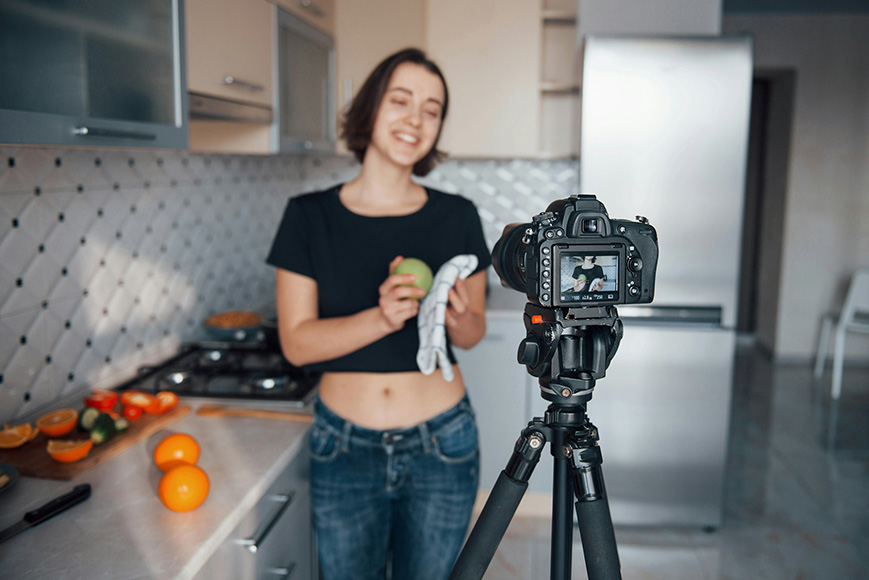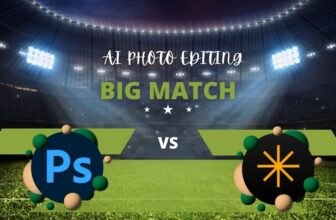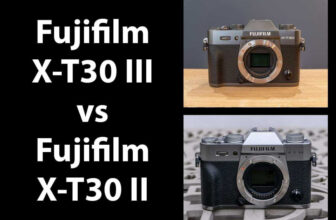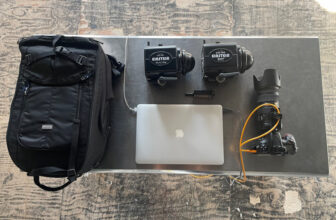
In this guide to the best lenses for YouTube videos, we’ll unbox all the necessary info, tips, and optics for any beginner YouTuber to produce stunning content.
Whilst it’s true that video is the king of online content, YouTube has become an incredibly crowded space.
The key to success in any YouTube video is having the best gear for the job, especially lenses!
I’ve been working on a YouTube photography-centric podcast for a year now, and while my MacBook camera is good, it’s not the same as having a DSLR or mirrorless camera and a sharp lens.
The right lens can elevate overall production values and video quality while also increasing viewer engagement and feedback.
Let’s take a look at the best beginner-friendly lenses for view-worthy YouTube videos.
Lens Basics: What to Know Before You Buy
Before you jump online or go old-school and walk into a camera store, stop and consider the basics you need to know before you drop any cash.
Camera lenses come in various shapes, sizes, focal lengths, and apertures and are available for a wide range of camera mounts and systems.
Understanding how the core lens specifications alter the look and feel of any YouTube video is essential.
Focal Length
A lens’ focal length refers to the distance between the camera’s image sensor (where light is gathered) and the optical centre of the fitted lens.
The focal length determines the field of view (angle of view) when looking through the viewfinder, rear LCD, or via a monitor when tethering to a computer. The field of view equates to how much of the scene you can see in the shot.
Focal lengths can range from a full-frame 10mm with an ultra-wide field of view for up-close subjects to a telephoto 800mm with a compressed field of view for distant subjects.
Depending on the style and format of the YouTube video, the content creator could opt for a wide-angle lens for vlogging or unboxing videos and a telephoto lens for capturing related B-roll content of a distant subject.
Aperture


Aperture refers to the internal diaphragm of a lens, which contracts and expands to control the amount of light passing through it to the camera’s image sensor.
Lenses feature an aperture range that determines the widest (or fastest) aperture setting to allow more light in, and the narrowest (slowest) aperture setting to restrict the amount of light.
The aperture directly impacts two key compositional elements: the exposure, or amount of light, and the depth of field, or how much of the foreground, middle ground, and background is in focus.
For example, the Nikon Z 35mm f/1.4 features an f/1.4 to f/16 aperture range. f/1.4 is the widest aperture setting that allows more light into the lens to hit the camera sensor.
f/1.4 also results in a shallow or narrow depth of field where the central subject may be in focus, but the foreground and background elements are blurry.
A narrow f/16 aperture significantly restricts the light passing through the lens, resulting in darker images. It also creates a broad depth of field where every element in the composition is in sharp focus.
It’s also worth knowing that the faster the maximum aperture, the more expensive the lens will be. An f/1.2 max aperture lens will cost around 2-3 times as much as some f/4 lenses with the same focal length.
Prime vs Zoom


A prime lens features a single focal distance, such as 16mm, 35mm, or 85mm. You’ll have to zoom in with your feet to get closer to the subject.
A zoom lens features a variable focal distance with set limits at each end of the range.
For example, a Tamron 28-75mm f/2.8 G2 is a zoom lens with a 28-75mm focal range.
At the wide 28mm end of the lens, you can vlog, shoot landscapes, and group shots. At the long 75mm end, you can shoot portraits, products, and food as the field of view is narrower or compressed.
Zooms are far more flexible than primes, but often feature narrower apertures than a prime.
If you don’t know your style yet, choose a zoom first – possibly even a kit 24-70mm lens – until you know what and how you like to shoot.
After that, you should better know what focal lengths you want to shoot at and be able to add a prime lens to your kit that fits your style.
Read more about primes vs zooms here.
Bells & Whistles


With advances in optical and digital technology, many current-gen YouTube-ready lenses boast additional features to optimize outcomes, quality, and user experience.
One of the most common features is optical image or lens stabilization (OIS). OIS is a lens-based stabilization system that gently moves the lens focus elements to retain a stable image.
OIS is ideal for handheld shooting, vlogging, and working in darker settings.
However, if you’re desk mounting your camera, using a tripod, or gimbal, you should turn OIS and In-Camera Image Stabilization off.
Another common feature is the inclusion of lens weather-sealing. A weather-sealed, or weather-resistant lens, is ideal for outdoor work regardless of the conditions.
Weather-resistant lenses are designed to withstand moisture and rain, freezing conditions, and dust. As a result, you can continue filming your YouTube content regardless of the weather.
The final consideration when selecting a video-friendly lens is how noisy it is. Many lenses feature aperture rings that make an audible click when changing the aperture setting.
Additionally, many lenses produce small but noticeable winding noises as the focus motor moves the lens element to maintain focus. A noisy lens will result in unwanted audio distraction in your YouTube content, especially if using off-camera microphones.
Select a lens with a de-clickable aperture ring that promises near-silent autofocus performance.
Compatibility with Your Camera
Canon, Fujifilm, Sony, Nikon, LUMIX, and Leica all feature a unique and proprietary lens mount on the front of the cameras. The lens mount is the metal bracket that the lens slots into and locks into place.
Leading brands make high-precision lenses that perfectly fit their camera systems. Third-party brands also make high-quality lenses to suit various camera lens mounts.
Pairing a Nikon Z8 mirrorless camera with a Canon RF lens is impossible, as the camera lens mount and the lens bayonet don’t match. Similarly, pairing a Nikon DSLR lens with a Nikon mirrorless body without a lens adapter is impossible.
Consequently, when selecting the right lens for your next YouTube project, ensure it’s fully compatible with your camera lens mount and operating system.
If you’re selecting a third-party lens for your camera system, ensure that the lens features autofocus and digital connectivity to allow the camera to control focus effectively.
The 4 Types of Camera Lenses Most Used for Making YouTube Videos
As with any photography and videography genre, there’s a range of most-used or highly-recommended lenses for YouTube video and content creation.
Of course, selecting the correct lens type is determined by two critical factors: the style of content you wish to record and your budget.
If you only wish to record talking head content while seated at your desk, you only need a wide-angle lens with a relatively fast maximum aperture.
However, if you intend to record sports-related content for your YouTube channel, you’ll need a telephoto lens to zoom in on the action from a distance.
Let’s look at the four types of camera lenses for YouTube videos.
Wide-Angle Lenses


A wide-angle lens is designed to capture a wide field of view. It typically covers a full-frame focal distance of up to 35mm.
For example, the Canon RF 15-35mm f/2.8 L IS USM full-frame zoom offers a wide 15-35mm focal distance. Read our full review!
Full-frame 15-35mm delivers an ultra-wide 110° 30′ to 63° field of view, wide enough to capture groups of people or scenery from a distance.
It’s also an ideal lens for working in a small space or studio with little distance between the camera/lens and the main subject.
As a result, wide-angle lenses are an excellent choice for vlogging, whether handheld or with a gimbal. The wide field of view allows you to hold the camera approximately at arm’s length while keeping your head in frame at all times.
Wide-angle can also be great for top-down views of your workspace while recording unboxing and product videos for YouTube.
Standard Lenses


A standard lens covers a full-frame focal length between 35mm and 85mm. It delivers a more natural field of view that covers between 65º and a compressed 28º.
Standard lenses are ideal for YouTube content where you conduct sit-down interviews, product reviews, and food shots.
One of the most common standard lenses for YouTube video content is the nifty-fifty, or full-frame equivalent 50mm lens.
A 50mm lens delivers a relatively natural and undistorted 46º field of view with enough space to fit a subject and some background elements in the frame.
The Sigma 50mm f/1.4 DG DN Art lens for Sony full-frame E-mount cameras is an excellent example.
Telephoto Lenses


A telephoto lens is used for much longer shots where you are far from your subject.
Capturing video content of a distant subject with a wide-angle lens makes them look tiny in the frame. However, with a telephoto lens, you bring the subject in close and frame them centrally in the shot.
The telephoto lens focal distance covers anything from approximately 85mm full-frame upwards. That equates to around a 30º field of view down to as compressed as a 3º or 4º with an 800mm lens.
While they serve a purpose, telephoto lenses are used less in YouTube video content creation than wide and standard lens options.
Macro Lenses


The final lens type used in countless YouTube videos is the macro lens. A macro lens offers a tight field of view and the ability to gain high levels of detail from subjects.
Depending on the focal length, a macro lens is perfect for capturing small or even minute details in a product review video.
The Canon RF 100mm f/2.8 L Macro IS USM macro lens is a great example. It features a 4x magnification and an accurate 1:1 life-size replication of the subject on the image sensor.
Macro lenses are incredibly sharp and also make for exceptional portrait lenses.
Recommended Lenses for Shooting YouTube Videos


Now that we’ve covered the lens basics and the best types of lenses for YouTube videos, it’s time to get specific.
The following section will cover lenses boasting YouTube-friendly focal distances, apertures, and more!
Plus, our list of recommended lenses covers all popular DSLR and digital mirrorless camera systems.
35mm f/1.4 (Ideal Prime for Vlogging)


A 35mm prime lens with a fast f/1.4 max aperture is the best combination for any YouTuber recording vlogs where they hold the camera at arm’s length with or without a gimbal.
The wide 35mm full-frame equivalent focal distance always keeps the content creator’s head and upper torso in frame.
Plus, with a fast and wide f/1.4 maximum aperture, your face will retain sharp focus while the background elements will appear soft, out-of-focus, and blurred.


I recommend activating the camera’s face and eye subject detection and tracking system in the autofocus menu for optimal results.
That way, even if you’re on the move, the camera will maintain crisp focus on your face.
While f/1.4 lenses are ideal, they’re also costly, so go for f/1.8 if you’re on a budget. However, f/1.4 lenses are usually much better made (in addition to having the extra stop of light).
An excellent example is the Fujifilm XF 23mm f/1.4 lens, which offers a 35mm full-frame equivalent focal distance and a fast max aperture.
Nikon Z [B&H] Nikon FX [Amazon | B&H] | Nikon DX [Amazon | B&H] | Canon EF [Amazon | B&H] | Canon APS-C [Amazon | B&H] | Canon RF [B&H] | Sony FE [Amazon | B&H] | Sony APS-C [Amazon | B&H] | Fujifilm [Amazon | B&H] | Micro Four-Thirds [Amazon | B&H]
16mm f/1.4 (Best APS-C Prime for Vlogging)


Plenty of YouTube videos are recorded on cropped-sensor APS-C cameras such as those made by Fujifilm, Sony, Nikon, and Canon.
A cropped sensor is smaller than a full-frame one, so APS-C format lenses are specific to those camera systems.
An APS-C lens such as the Sigma 16mm f/1.4 DC DN Contemporary lens (for Nikon Z APS-C cameras) offers a 24mm full-frame equivalent focal distance. Read our full review here.
The same Sigma lens is available for all APS-C camera systems, including Nikon Z, Canon EF, Canon RF, Sony, Fujifilm, and Micro Four Thirds.


Sigma’s APS-C champion is weather-sealed, features fast focus performance, and produces exceptionally sharp, bright images that reproduce natural color perfectly.
At 24mm full-frame, the wider 83º field of view is perfect for capturing wide scenes or handheld vlogging.
Nikon Z APS-C [Amazon | B&H] | Canon EF-M [Amazon | B&H] | Canon RF APS-C [B&H] | Sony APS-C [Amazon | B&H] | Fujifilm [Amazon | B&H] | Micro Four-Thirds [Amazon | B&H]
24-70mm f/2.8 or 28mm-70mm f/2.8 (Best Standard Zoom Lens for YouTube Videos)


One of the best standard zoom lenses for YouTube video is the good old 24-70 full-frame kit lens. A kit lens is typically included in a bundle with a new camera.
A full-frame 24-70mm or 28-70mm standard zoom is one of the most universal and flexible choices for any photography or videography project.
The 24/28mm wide end is perfect for vlogging and capturing wide shots of scenery, landscapes, and streets. At the 70mm end, you’ll capture products, food, portraits, and close-up work requiring a tighter field of view.
A standard zoom lens is ideal for YouTubers who shoot a wide range of content and need versatility in the focal range. However, zoom lenses don’t offer the same bright max apertures as many primes.


Almost all brands offer this lens, but Sigma is the best value.
If you’re ok with a little less on the wide end, the Tamron 28-75mm f/2.8 G2 [Amazon | B&H] and the Sigma 28-70mm f/2.8 [Amazon | B&H] are both excellent lenses at great prices.
(The price of the Tamron for Sony right now is fantastic, although I prefer the Sigma – the shots come out less clinical. I actually really love the Sigma 28-70mm.) Read our full Tamron 28-75mm review.
If you prefer a native lens, you can choose from the links below. (APS-C equivalents provided).
Nikon FX [Amazon | B&H] | Nikon DX [Amazon | Canon EF [Amazon | B&H] | Canon APS-C [Amazon | B&H] | Canon RF [Amazon | B&H] | Sony FE [Amazon | B&H] | Sony E [Amazon | B&H] | Fujifilm [Amazon | B&H] | Micro Four-Thirds [Amazon | B&H]
16-35mm f/2.8 (Most Versatile Lens for YouTube Vlogging)


While a 24mm or 35mm full-frame equivalent prime lens is great for vlogging, sometimes you need a little more flexibility.
A full-frame 16-35mm wide-angle zoom lens covers the exact focal distances required for recording on-the-go YouTube videos. However, the flexible zoom range grants you greater creative freedom to record video content at different focal lengths.
Read our complete Sony FE 16-35mm f/2.8 review.
Even at the ultra-wide 16mm, the content is appealing yet not distorted. The Canon RF f/2.8 is a slightly wider 15-35mm, and an even wider 14-35mm as an f/4 lens. As for Nikon, the Nikon Z version is the 14-30mm f/4.
APS-C versions will be somewhere between 10-23mm, depending on the brand (closest equivalents in the links below).


If you already have the 24-70mm or the 28-70mm, go for the 14-24mm. Otherwise, this is a great zoom lens for those needing a larger field of view and the versatility of a zoom lens.
Once again, the f/2.8 max aperture ensures excellent light and center subject sharpness with background blur. However, if the f/2.8 is out of your price range, the f/4 is easier on the wallet.
f/2.8:
Nikon DX [Amazon | B&H] | Canon EF [Amazon | B&H] | Canon APS-C [Amazon | B&H] | Canon RF [Amazon | B&H] | Sony FE [Amazon | B&H] | Micro Four-Thirds [Amazon | B&H]
f/4:
Nikon Z [Amazon | B&H] Nikon FX [Amazon | B&H] | Nikon DX [Amazon | B&H] | Canon EF [Amazon | B&H] | Canon APS-C [Amazon | B&H] | Canon RF [Amazon | B&H] | Canon RF APS-C [ B&H] |Sony FE [Amazon | B&H] | Sony APS-C [Amazon | B&H] | Fujifilm [Amazon | B&H]
Sony 20-70mm f/4 (Best Sony Lens for YouTube Beginners)


Sony Alpha digital mirrorless cameras are incredibly popular for YouTube video creation. They offer exceptional hybrid photography/videography performance and some neat video specs.
If you’re rocking a Sony A camera, the Sony FE 20-70mm f/4 G is one of the best beginner-friendly lenses for recording YouTube videos.
The full-frame Sony 20-70mm is a fantastic all-in-one lens for video, as long as you don’t need the extra f-stops of light. It’s a decent price and highly versatile, from ultra-wide angle to portrait focal length.
As a result, the Sony 20-70mm can be used for everything from vlogging to interviews.
Plus, Sony has designed this lens with specific video-centric features in mind. It effectively manages focus breathing (where the focus shifts in and out slightly while recording) while supporting in-camera image stabilization and micro-step aperture control.
The Sony 20-70mm also features an aperture ring On/Off switch to prevent the ring from making excessive noise while recording.
50mm f/1.4 (Best All-Around Prime)


As mentioned earlier, a nifty-fifty (50mm full-frame equivalent) lens is one of the most essential lens choices for any kit, regardless of genre.
A 50mm focal distance is quite flexible as it can record interview-style content, products, food, and much more.
One of the most sought-after prime lenses in videography and photography is a 50mm f/1.4 that delivers centre sharpness and gorgeous background blur.
The Sigma 50mm f/1.4 [Amazon | B&H] is a fantastic option for Sony E, Nikon F, Canon EF, and Leica L.


For a native Nikon full-frame, the Nikon Z 50mm f/1.4 is an exceptional and affordable full-frame lens. If you’re shooting with a Canon R system, the Canon RF 50mm f/1.4 VCM is just as sharp and equally cheap.
The APS-C equivalent is the 35mm f/1.4 (as seen in the links below), which is around 52mm on most APS-C cameras. If f/1.4 is too pricy, go with an f/1.8 for outstanding results.
Native lens options:
Nikon FX [Amazon | B&H] | Canon EF [Amazon | B&H] | Sony FE [Amazon | B&H] Canon RF [ Amazon | B&H ] Nikon Z [ Amazon | B&H ]
Nikon DX [Amazon | B&H] | Nikon Z APS-C [Amazon | B&H] | Canon EF APS-C [Amazon | B&H] | Canon RF APS-C [Amazon | B&H] | Sony APS-C [Amazon | B&H] | Fujifilm [ B&H] | Micro Four-Thirds [Amazon | B&H]
3 Tips for Choosing the Right Lens for Your Video Style


Here are our best tips for choosing the right lens for your YouTube videos.
Tip 1 – Start Simple
If you want a lens to record your next YouTube video masterpiece, I recommend starting with a simple 24-70mm full-frame equivalent kit lens.
A 24-70mm focal range is incredibly flexible for recording a wide range of content styles, either indoors or outdoors.
24-70mm full-frame kit lenses, or 16-50mm APS-C kit lenses, typically feature a constant f/2.8 maximum aperture or a f/2.8 (wide end) to f/4 (long end) aperture range.
With this focal range and aperture, you can create bright, sharp, and detailed video content that is ideal for YouTube.
Tip 2 – Build Your Kit Slowly
Rather than rush out to your camera store and buy every lens for every possible YouTube video style, build your kit over time.
As mentioned above, start with the kit lens likely packaged with your DSLR or mirrorless camera. Attempt to use it for every style of content you wish to capture indoors and outdoors.
Review your content after a few months of use and determine the most common focal length used.
If you’re always shooting at the widest end of the lens (24mm full-frame) and could use a shallower depth of field, consider getting a 24mm prime lens with a faster f/1.4 or f/1.8 aperture.
If you find that you’re recording content at the 70mm end and still attempt to zoom in with your feet, consider a telephoto 85mm fast prime or a telephoto 70-200mm zoom.
Add one lens to your kit at a time.
Tip 2 – Third-Party Lenses Are Ace
While many content creators prefer to work with lenses native to their camera system (Canon lenses on a Canon camera), reputable third-party brands also make outstanding lenses for every camera mount possible.
Third-party lenses offer excellent value for money, optical performance, and compatibility while sometimes delivering better outcomes than branded glass.
An excellent example is the Sigma 18-50mm f/2.8 DC DN Contemporary lens for Fujifilm X Series cameras. It offers a versatile 27-75mm full-frame equivalent focal distance and a bright and constant f/2.8 maximum aperture.
While the equivalent first-party Fujifilm 16-50mm f/2.8-4.8 R LM WR is equally as sharp and has incredible image clarity, it doesn’t feature a constant f/2.8 aperture. As a result, the f/4.8 aperture is substandard for specific situations at the 50mm long end.
FAQs About the Best Lenses for YouTube Videos
What is the best lens for video quality?
The best lens for video quality is determined primarily by your budget! If you can’t afford the best f/1.2 version of a focal distance, opt for the f/1.4, f/1.8, or even f/2.8 equivalent.
What lens do most vloggers use?
Most vloggers use a 16-35mm f/2.8 wide-angle zoom lens, as it offers flexibility while accommodating the most desired focal range for handheld (selfie) shooting. The f/2.8 constant max aperture ensures consistency in image brightness and manages depth of field.
Can I use my kit lens for YouTube videos?
Yes! A kit lens is an ideal first lens for YouTube videos. Most kit lenses cover a 24-70mm full-frame equivalent focal distance, suitable for vlogging, product showcases, talking head interviews, and food videos.
What lenses are best for filmmaking?
The best glass for pro-grade filmmaking is cine or cinema lenses. Rather than f-stops to control the aperture, cine lenses feature more accurate T-stops to precisely control the depth of field and incoming light. Photographers look for the quality of in-focus areas, and filmmakers look for the quality of the out-of-focus areas.
What is the most common lens for video?
The most common lens for high-quality video recording is the 24-70mm full-frame zoom lens with a fast constant f/2.8 aperture. The Canon RF 24-70mm f/2.8 L IS USM lens is an excellent example of this style.
What focal length is best for YouTube videos?
Most YouTube videos are recorded with a full-frame focal length between 24mm and 50mm. Of course, if you’re vlogging, you’ll need a wider focal length; if you’re shooting products or food, you’ll need a longer telephoto length.
Do I need a wide-angle lens for vlogging? Won’t it make things look distorted?
For vlogging, you need a wide-angle prime or zoom lens to ensure that your face and upper body are in frame while holding the camera at arm’s length. A 24mm or 35mm full-frame focal distance is ideal without overly distorting the subject.
Credit : Source Post






